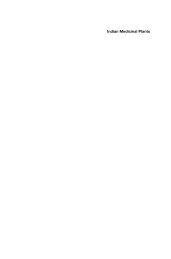a-collection-of-research-articles-on-the-medical-potential-of-cow-urine
a-collection-of-research-articles-on-the-medical-potential-of-cow-urine
a-collection-of-research-articles-on-the-medical-potential-of-cow-urine
You also want an ePaper? Increase the reach of your titles
YUMPU automatically turns print PDFs into web optimized ePapers that Google loves.
ISSN NO 2320-5407 Internati<strong>on</strong>al Journal <str<strong>on</strong>g>of</str<strong>on</strong>g> Advanced Research (2013), Volume 1, Issue 5, 71-78<br />
4 m probably <strong>on</strong>ly being reached in around 2,000-<br />
4,000 years. Thuner is <strong>the</strong> oldest plant at high altitude<br />
regi<strong>on</strong> <str<strong>on</strong>g>of</str<strong>on</strong>g> Uttarakhand. Most parts <str<strong>on</strong>g>of</str<strong>on</strong>g> <strong>the</strong> tree are<br />
toxic, except <strong>the</strong> bright aril surrounding <strong>the</strong> seed,<br />
enabling ingesti<strong>on</strong> and dispersal by birds. The major<br />
toxin is <strong>the</strong> alkaloid taxane. Phytochemical analysis<br />
<str<strong>on</strong>g>of</str<strong>on</strong>g> extracts <str<strong>on</strong>g>of</str<strong>on</strong>g> leaves and bark showed <strong>the</strong> presence <str<strong>on</strong>g>of</str<strong>on</strong>g><br />
lignans, flav<strong>on</strong>oid, glycosides, sterols, sugar, amino<br />
acid, and triterpenoid, alkaloids, steroids, tannins,<br />
mucilage, fixed oil, phenolic compounds and<br />
protein.The leaves are <strong>the</strong> principal source <str<strong>on</strong>g>of</str<strong>on</strong>g> taxol;<br />
<strong>the</strong> anti-cancer drug, but has not been widely<br />
exploited in this c<strong>on</strong>necti<strong>on</strong> (Hartzell, 2003).<br />
C<strong>on</strong>sidering <strong>the</strong> severity <str<strong>on</strong>g>of</str<strong>on</strong>g> cancer as a<br />
disease <str<strong>on</strong>g>of</str<strong>on</strong>g> man and animals and complexity <str<strong>on</strong>g>of</str<strong>on</strong>g><br />
<strong>the</strong>rapeutic approaches and <strong>the</strong>ir harmful side effects,<br />
it was planned to study <strong>the</strong> effect <str<strong>on</strong>g>of</str<strong>on</strong>g> Taxusbaccata<br />
preparati<strong>on</strong> al<strong>on</strong>g with <strong>cow</strong> <strong>urine</strong> distillate in mice as<br />
measured through clinical haematology<br />
Materials and Methods<br />
1. Extract preparati<strong>on</strong><br />
Extracts <str<strong>on</strong>g>of</str<strong>on</strong>g> leaves and bark <str<strong>on</strong>g>of</str<strong>on</strong>g> T. baccata were<br />
prepared by applying <strong>the</strong> standard methods with<br />
different solvents like; Aqueous, ethanol, methanol<br />
and e<strong>the</strong>r as described by Govindachariet al., (1999)<br />
and Udupaet al., (1995).<br />
In-vivo study<br />
2. Experimental design<br />
Present study was performed in mice maintained in<br />
<strong>the</strong> experimental animal house in Institute <str<strong>on</strong>g>of</str<strong>on</strong>g><br />
Biotechnology, G.B. Pant University <str<strong>on</strong>g>of</str<strong>on</strong>g> Agriculture<br />
and Technology, Patwadangar, Nainital, Uttarakhand,<br />
India. A total <str<strong>on</strong>g>of</str<strong>on</strong>g> 97 animals were equally divided into<br />
11 groups. The mice were housed in clean<br />
polypropylene cages and fed adlibitum with<br />
commercially available feed and water. The<br />
experiment was carried out in accordance with <strong>the</strong><br />
Instituti<strong>on</strong>al Animal Ethical Committee (IAEC), G.B.<br />
Pant University <str<strong>on</strong>g>of</str<strong>on</strong>g> Agriculture and Technology,<br />
Pantnagar, Uttarakhand, India. The 11 groups<br />
were:C<strong>on</strong>trol group(9 mice), Negativec<strong>on</strong>trol(DEN<br />
treated mice)(8 mice), CUD(without DEN)(8 mice),<br />
A (Aqueous extract <str<strong>on</strong>g>of</str<strong>on</strong>g> leaves <str<strong>on</strong>g>of</str<strong>on</strong>g> Taxusbaccata)(8<br />
mice), (Ethanolic extract <str<strong>on</strong>g>of</str<strong>on</strong>g> leaves <str<strong>on</strong>g>of</str<strong>on</strong>g><br />
Taxusbaccata)(8 mice), G(Methanolic extract <str<strong>on</strong>g>of</str<strong>on</strong>g> bark<br />
<str<strong>on</strong>g>of</str<strong>on</strong>g> Taxusbaccata)(8 mice), H(E<strong>the</strong>r extract <str<strong>on</strong>g>of</str<strong>on</strong>g> Bark <str<strong>on</strong>g>of</str<strong>on</strong>g><br />
Taxusbaccata)(8 mice), CUD(Cow Urine<br />
Distillate)(with DEN)(8 mice), CUD+A(8 mice),<br />
CUD+B(8 mice), CUD + G(8 mice), CUD+H (8<br />
mice).<br />
Single dose <str<strong>on</strong>g>of</str<strong>on</strong>g> diethyl nitrosamine (DEN) @ 200<br />
μl/kg body weight was given to each mice <str<strong>on</strong>g>of</str<strong>on</strong>g><br />
negative c<strong>on</strong>trol group and tests groups. 500 ml <str<strong>on</strong>g>of</str<strong>on</strong>g><br />
each extract were made by adding 20% <str<strong>on</strong>g>of</str<strong>on</strong>g> extract in<br />
500ml <str<strong>on</strong>g>of</str<strong>on</strong>g> distilled water (Kumar et al., 2004b). The<br />
mice <str<strong>on</strong>g>of</str<strong>on</strong>g> 9 test groups were given different extracts <str<strong>on</strong>g>of</str<strong>on</strong>g><br />
taxusbaccata al<strong>on</strong>e and in combinati<strong>on</strong> with CUD<br />
(2ml/day/mice), daily p.o., from day 1 for 6 m<strong>on</strong>ths;<br />
however, <strong>the</strong> mice <str<strong>on</strong>g>of</str<strong>on</strong>g> negative c<strong>on</strong>trol group were<br />
maintained with routine feed and water.Body weight<br />
<str<strong>on</strong>g>of</str<strong>on</strong>g> mice were taken regularly at an interval <str<strong>on</strong>g>of</str<strong>on</strong>g> 15 day<br />
till <strong>the</strong> end <str<strong>on</strong>g>of</str<strong>on</strong>g> <strong>the</strong> experiment.Total leucocyte count<br />
(TLC), absolute neutrophil count (ANC), absolute<br />
leucocyte count (ALC), hemoglobin, total erythrocyte<br />
count (TEC) and hemoglobin (Hb) c<strong>on</strong>tent <str<strong>on</strong>g>of</str<strong>on</strong>g> all <strong>the</strong><br />
experimental animals in different groups were<br />
determined regularly at an interval <str<strong>on</strong>g>of</str<strong>on</strong>g> 15 day till <strong>the</strong><br />
end <str<strong>on</strong>g>of</str<strong>on</strong>g> <strong>the</strong> experiment as per in standard procedures<br />
(Chauhan, 2005).<br />
Results<br />
In-vivo study was carried out in mice using DEN as<br />
carcinogen and plant extracts al<strong>on</strong>e and/or<br />
combinati<strong>on</strong> with CUD as test material for a period<br />
six m<strong>on</strong>th.<br />
Body Weight<br />
Body weight <str<strong>on</strong>g>of</str<strong>on</strong>g> mice were taken in gram at an<br />
interval <str<strong>on</strong>g>of</str<strong>on</strong>g> 15 days till <strong>the</strong> end <str<strong>on</strong>g>of</str<strong>on</strong>g> experiment. Data <str<strong>on</strong>g>of</str<strong>on</strong>g><br />
body weight change during experiment were givens<br />
in table-1. Initially, <strong>the</strong> mean bodyweight <str<strong>on</strong>g>of</str<strong>on</strong>g> c<strong>on</strong>trol<br />
was 21.47±1.21 gm and after 6 m<strong>on</strong>th <strong>the</strong> mean body<br />
weight <str<strong>on</strong>g>of</str<strong>on</strong>g> mice was 25.86±1.87 gm. In DEN<br />
(negative c<strong>on</strong>trol) treated group <strong>the</strong> initial mean body<br />
weight at zero day <str<strong>on</strong>g>of</str<strong>on</strong>g> experiment was 22.73±1.33 gm,<br />
which decreased to 19.16±1.81 gm at <strong>the</strong> end <str<strong>on</strong>g>of</str<strong>on</strong>g><br />
experiment. But in CUD treated group mean body<br />
weight at zero day was 22.43±1.36 gm and at <strong>the</strong> end<br />
<str<strong>on</strong>g>of</str<strong>on</strong>g> experiment it was 23.91±1.21 gm.CUD treated<br />
group in which <strong>the</strong> carcinogen has been given, <strong>the</strong><br />
initial mean body weight at zero day was 21.42±1.56<br />
gm. After <strong>the</strong> end <str<strong>on</strong>g>of</str<strong>on</strong>g> experiment, <strong>the</strong> mean body<br />
weight was 21.06±1.91 gm. In test group A, <strong>the</strong> zero<br />
day mean body weight 23.13±1.54 gm, which<br />
marginally increased at <strong>the</strong> end <str<strong>on</strong>g>of</str<strong>on</strong>g> experiment to<br />
23.52±1.01gm.In <strong>the</strong> group CUD+A <strong>the</strong> mean in<br />
body weight at zero day was 21.36±1.47 gm which<br />
was 26.48±0.902 at <strong>the</strong> end <str<strong>on</strong>g>of</str<strong>on</strong>g> experiment. In <strong>the</strong><br />
group CUD+B, <strong>the</strong> mean body weight was<br />
22.76±1.44 gm at zero day and was 24.80±1.09 gm at<br />
<strong>the</strong> end <str<strong>on</strong>g>of</str<strong>on</strong>g> experiment. In CUD+G and CUD+H<br />
groups, <strong>the</strong> mean body weight at zero day was<br />
22.97±1.37 gm and 22.81±1.21 gm which was<br />
increased to 24.67±0.941 gm and 24.60±1.01 gm at<br />
<strong>the</strong> end <str<strong>on</strong>g>of</str<strong>on</strong>g> <strong>the</strong> experiment. In group B, G and H, <strong>the</strong><br />
mean body weight at zero day was found 22.81±1.26<br />
gm, 22.41±1.32 gm and 22.51±1.28 gm respectively<br />
and at <strong>the</strong> end <str<strong>on</strong>g>of</str<strong>on</strong>g> experiment <strong>the</strong> body weight reaches<br />
72









